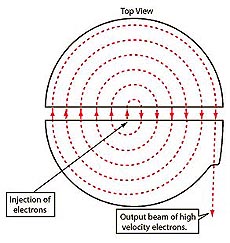Turning up the energy
 |
| Click to view complete cyclotron illustration in Hyperphysics. The particle beam traverses the cyclotron gap starting near the center. It first moves from the bottom electrode to the top. Then the voltage reverses so that the beam can now cross over from the top electrode to the bottom. This pattern continues, and, with the help of a magnetic field, the beam travels in a gradually outward-moving path until it exits the cyclotron. Image: Hyperphysics |
In my last column we began building a practical particle accelerator by stringing a series of radio-frequency cavities together to achieve beam energies extending into the billion-electronvolt range, the final energy depending on our persistence, wealth and available real estate. The lack of one or more of these attributes forces a more clever solution.
In 1932 Ernest Lawrence provided such a solution with his invention of the cyclotron. By this time the behavior of charged particles in magnetic and electric fields was well understood, and large electric fields had been used to accelerate protons and electrons. Lawrence's idea was to pass a beam of charged particles through a single accelerating gap many times instead of stringing many gaps together in a line. He used a magnetic field to bend the beam in a circular path, causing it to pass through two accelerating gaps on each orbit. As the beam increases in energy, it bends less in the magnetic field, resulting in a spiral path.
The beam, the magnetic field and the two accelerating gaps were contained in a vacuum chamber. The source of the magnetic field was a large electromagnet located outside the vacuum chamber. Inside the chamber were two separate D-shaped half cylinders that served as the electrodes for the accelerating voltage (see figure above). An oscillating voltage applied to the electrodes reversed direction with each half orbit of the beam so that the particles would be accelerated in both gaps (from the negative to the positive electrode, then from positive to negative, and so on). As the beam accelerated, it spiraled outward until, finally, it exited the chamber to be used for experiments. The first working cyclotron was only 10 inches in diameter and accelerated protons to 1 million electronvolts.
The primary limitation of a cyclotron is that large energies require large diameters, which means large, expensive vacuum chambers. In addition, as the beam particles approach the speed of light, the energy increases, but the velocity does not. Therefore, the time it takes to complete the longer orbits at high energy increases, and the synchronization with voltage is lost. Ed McMillan solved the synchronization problem by adjusting the phase of the voltage to match the orbital period through the acceleration cycle. However, both problems are resolved in a synchrotron where the magnetic field is ramped to higher values during the acceleration cycle to maintain the radius of the orbit at a constant value. This minimizes the requirements on the size of the vacuum chamber. Fermilab's 8-GeV Booster, its Main Injector and CERN's LHC are all examples of synchrotrons.
We moved very quickly from the most rudimentary linear and circular accelerators to the most sophisticated, leaving out many of the complex details. Future columns will examine some of the fascinating details of how these beautifully complex machines work. My goal is to qualify all Fermilab Today readers for the Main Control Room call-in list, which is used when one of the big synchrotrons needs to be tuned up. It's just like tuning a guitar with a very long neck.
—Roger Dixon
Want a phrase defined? Have a question? Email today@fnal.gov.
|